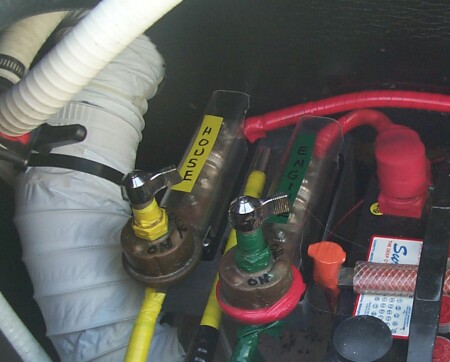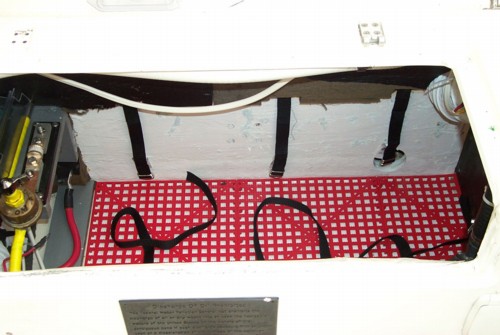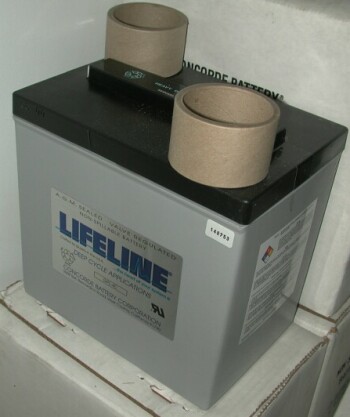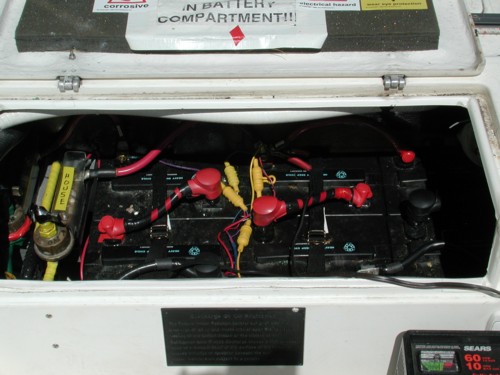Increasing our Battery Capacity
The center of a boats electrical system are the batteries that keep everything energized. In our Prout Escale, the batteries are kept in a small compartment just forward of the main traveler. There, they are afforded good ventilation and easy access, even if the amount of space is somewhat constrained.
As delivered, our Escale carried three car starter batteries - two to act as a house bank, the leftover to start the engine. Given that car starting batteries are totally inadequate for deep-cycle house bank applications, we replaced them initially with deep cycle batteries (Trojan Group 30H's). This gave us a comparatively puny 260 Ah house bank capacity which was OK for summer cruising but would fall well short when things got colder and the furnace kicks in. After retrofitting a powerful charging system, I felt it was time to evaluate new battery options.
I became increasingly interested in Absorbed Glass Matt (AGM) lead acid batteries since they offered a number of features not found in the flooded batteries we were using. While the initial purchase cost was quite a bit higher than the budget "deep cycle" batteries built by Trojan, Penn, and others, AGM promise to save us plenty of money over their life-cycle. To find out more, see my battery pages here. I lay out the pro's and con's of the three lead acid battery technologies in use today and also offer a cost model that you can download and use in Microsoft Excel.
Ultimately, I decided to fit the boat with Lifeline GPL4C batteries which allow us to have one battery type on board (they have more than enough cold-cranking capacity to start the diesel despite being deep cycle batteries). The battery compartment is getting a bit cramped but can accommodate the six cells that make up our house and starter banks. However, the immense current capacity of AGM batteries requires careful fusing and a charging system that can handle them (AGMs will bulk charge at up to 4X of Ah capacity and thus easily max. out a alternator). We had already replaced the charging system and some of the main bus wiring. Fuses were retrofit next.
As delivered, our Escale lacked proper fuse protection to fall inside the ABYC standards. The wires connecting the batteries to the circuit breakers were longer than ABYC standards allow for. Prout Catamarans evidently decided to save a few dollars by not installing high-amperage fuses "upstream" from the battery switches in the battery compartment. Given how well fiberglass burns, we decided that having a properly fused system was a top priority. We also ensured that all exposed terminals got covers slipped over them - cheap insurance against accidental shorts.
We improved the safety of our system by installing 200A Class T fuses right next to the batteries. The one metal object that is not screwed down in the battery compartment is the bilge pump handle. We covered it in several layers of electrical tape. All terminals are covered as well. No objects may be placed in this compartment, so we feel pretty good about it now.

Here is a picture of the compartment after the fuse retrofit but before we had installed our new AGM batteries. You can see how we cover specific wiring runs with electrical tape of one color to ensure that we can recognize them throughout the boat. Thus, the positive 00AWG house conductor is the standard red but covered with a spiral pattern of yellow electrical tape. Now we do not have to look for labels - the conductor identifies itself whether we are in the engine compartment, the Link Box, or the battery compartment.
Since we have a series-parallel system in the house bank (Four 6V batteries), we have decided to fuse the banks internally as well as externally. Class T fuses are the way to go for your main buses because of the very high interrupt capability - where other fuses can short out when they fail, the class T fuse will keep up to 20,000 amps isolated. At $13 each they are cheap insurance. In the picture are the two Blue Sea Class T fuse holders along with the switches that control the primary leads to engine and the link box. At left you can see a Attwood 4000 blower as well as a Y-switch for the starboard bilge pump.
We then prepared the locker for the installation of the new batteries. While the old flooded cell batteries could be restrained with a simple bar running across them left to right, the new cells required a hold-down strap for each set of batteries.
We started by removing the noise insulation that previously prevented the installation of GPL4Cs. Then, we repainted and waterproofed the whole section with epoxy paint. The matting followed, allowing the cells some breathing room underneath in case things get wet. The tie-down straps were installed last and may be revised in the future to include non-corrdoding hardware.

 And here is a picture of our long awaited upgrade for the electrical system: Six Lifeline GPL4C AGM batteries that will be wired in series (starter bank @ 2x6V) and series-parallel (house bank @ 2x(2x6V)). They will replace our current Surrette and Trojan Group 30H house and starter banks. We bought the Lifeline batteries at Ed's Batteries outside Portland, ME for USD 144 apiece. They store 200Ah each, can be used as starter batteries, will not vent unless severely overcharged, and require no maintenance once the charging system has been properly set up.
And here is a picture of our long awaited upgrade for the electrical system: Six Lifeline GPL4C AGM batteries that will be wired in series (starter bank @ 2x6V) and series-parallel (house bank @ 2x(2x6V)). They will replace our current Surrette and Trojan Group 30H house and starter banks. We bought the Lifeline batteries at Ed's Batteries outside Portland, ME for USD 144 apiece. They store 200Ah each, can be used as starter batteries, will not vent unless severely overcharged, and require no maintenance once the charging system has been properly set up.
The GPL4Cs were particularly attractive since they best fit the little battery room we have and will almost double the energy storage capacity on board. With both banks active, up to 1800 CCA will be available to start the engine - it only needs 130A under summer conditions. I'm looking forward to the day I can chuck the flooded cell related safety equipment and recharge my batteries without venting extremely corrosive gases. The more I can minimize maintenance, the better. Furthermore, AGMs discharge so little that winter storage will no longer require a battery haul out. Instead, we will attach a very small trickle charger from time to time.
Here is a picture of the four GPL4Cs installed in the battery compartment. The first set to the left is the starter bank, the two sets to the right constitute the house bank.All terminals save two have been wrapped and insulated. All three 12VDC sets of series-wired batteries are fused.

The fuses are hidden under the rather large terminal covers. This system has practically doubled our battery capacity while using about the same amount of footprint in the battery compartment. The GPL4Cs are remarkable because they are taller than most commonly batteries found on boats (the L-16 form factor is a notable exception).
Best Estimate for Time Required:
| Research fuse requirements | 2 hours |
|---|---|
| Research battery options, choose AGM, order | 10 hours |
| Buy Class T fuses and fuse mounts, install on mounts | 2 hours |
| Make new positive conductor jumper wires, insulate all metal surfaces/terminals | 3 hours |
| Prepare space, install new batteries, restrain properly, connect up | 10 hours |
| Total | 27 hours |
|---|


